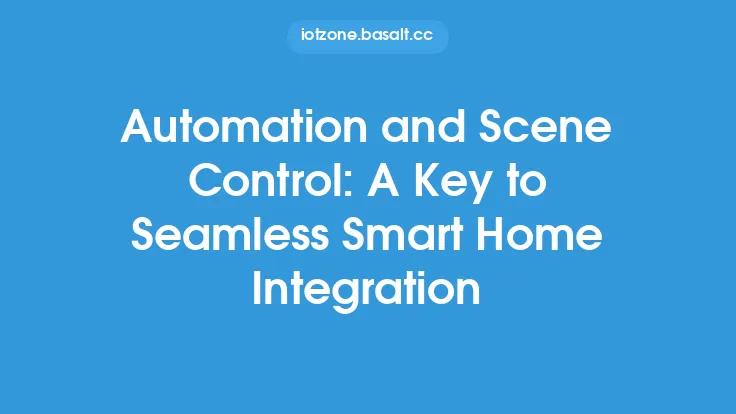The concept of smart lighting control has revolutionized the way we experience and interact with our living spaces. By integrating advanced technologies and innovative design principles, smart lighting systems have become an essential component of modern smart home automation. At its core, smart lighting control refers to the use of intelligent devices and systems to manage and regulate lighting levels, color temperatures, and ambiance in a home or building. This technology has far-reaching implications for enhancing home ambiance, improving energy efficiency, and promoting convenience and comfort.
What is Smart Lighting Control?
Smart lighting control involves the use of advanced technologies such as wireless communication protocols, sensors, and microcontrollers to control and manage lighting systems. These systems can be integrated with various devices and platforms, including smartphones, tablets, and voice assistants, to provide seamless control and monitoring of lighting levels. Smart lighting control systems can be categorized into several types, including centralized, decentralized, and hybrid systems. Centralized systems rely on a single controller or hub to manage all lighting devices, while decentralized systems use a network of distributed controllers to manage individual lighting devices. Hybrid systems, on the other hand, combine elements of both centralized and decentralized systems to provide a flexible and scalable lighting control solution.
Key Components of Smart Lighting Control Systems
Smart lighting control systems typically consist of several key components, including lighting devices, controllers, sensors, and communication protocols. Lighting devices can include LED bulbs, strips, and panels, as well as traditional incandescent and halogen bulbs. Controllers are the brain of the smart lighting system, responsible for processing commands and controlling the lighting devices. Sensors, such as occupancy sensors and light sensors, provide real-time feedback to the controller, enabling it to adjust lighting levels and color temperatures accordingly. Communication protocols, such as Wi-Fi, Bluetooth, and Zigbee, enable the controller to communicate with other devices and platforms, providing a seamless and integrated lighting control experience.
How Smart Lighting Control Works
Smart lighting control systems work by using a combination of sensors, controllers, and communication protocols to manage and regulate lighting levels. The process typically begins with the installation of smart lighting devices, which are connected to a controller or hub. The controller is then programmed to respond to various commands and inputs, such as occupancy sensors, light sensors, and voice commands. When a command is received, the controller processes the information and sends a signal to the lighting devices, adjusting their brightness, color temperature, and other parameters accordingly. The system can also be integrated with other smart devices and platforms, enabling seamless control and monitoring of lighting levels from anywhere in the world.
Benefits of Smart Lighting Control
The benefits of smart lighting control are numerous and well-documented. One of the most significant advantages is energy efficiency, as smart lighting systems can automatically adjust lighting levels to minimize energy consumption. Smart lighting control systems can also enhance home ambiance, providing a range of color temperatures and lighting effects to suit different moods and activities. Additionally, smart lighting control systems can improve convenience and comfort, enabling homeowners to control lighting levels from anywhere in the world using their smartphones or voice assistants. Other benefits of smart lighting control include increased safety and security, as well as enhanced home value and appeal.
Technical Considerations
From a technical perspective, smart lighting control systems require careful consideration of several factors, including power supply, communication protocols, and device compatibility. Power supply is a critical factor, as smart lighting devices require a stable and reliable power source to function correctly. Communication protocols, such as Wi-Fi and Bluetooth, must also be carefully selected to ensure seamless communication between devices and platforms. Device compatibility is another important consideration, as smart lighting devices must be compatible with the controller and other devices in the system. Other technical considerations include latency, interference, and security, which must be carefully managed to ensure a reliable and efficient smart lighting control system.
Installation and Configuration
Installing and configuring a smart lighting control system requires careful planning and attention to detail. The first step is to select the right smart lighting devices and controller for the system, taking into account factors such as power supply, communication protocols, and device compatibility. The next step is to install the devices and controller, following the manufacturer's instructions and ensuring that all connections are secure and reliable. Once the system is installed, it must be configured to respond to various commands and inputs, such as occupancy sensors and voice commands. This typically involves programming the controller and integrating it with other devices and platforms, such as smartphones and voice assistants.
Maintenance and Troubleshooting
Maintaining and troubleshooting a smart lighting control system requires regular monitoring and maintenance to ensure optimal performance and efficiency. This includes checking for software updates, monitoring energy consumption, and troubleshooting any issues that may arise. Regular maintenance can help prevent problems such as device failure, communication errors, and security breaches, ensuring that the system continues to function correctly and efficiently. Troubleshooting typically involves identifying the source of the problem, such as a faulty device or communication error, and taking corrective action to resolve the issue. This may involve replacing devices, updating software, or adjusting system settings to optimize performance and efficiency.
Conclusion
In conclusion, smart lighting control is a powerful technology that has revolutionized the way we experience and interact with our living spaces. By integrating advanced technologies and innovative design principles, smart lighting systems have become an essential component of modern smart home automation. Whether you're looking to enhance home ambiance, improve energy efficiency, or promote convenience and comfort, smart lighting control has something to offer. With its numerous benefits, technical considerations, and installation and configuration requirements, smart lighting control is a complex and multifaceted technology that requires careful planning and attention to detail. However, with the right knowledge and expertise, smart lighting control can be a powerful tool for creating a more comfortable, convenient, and sustainable living space.





